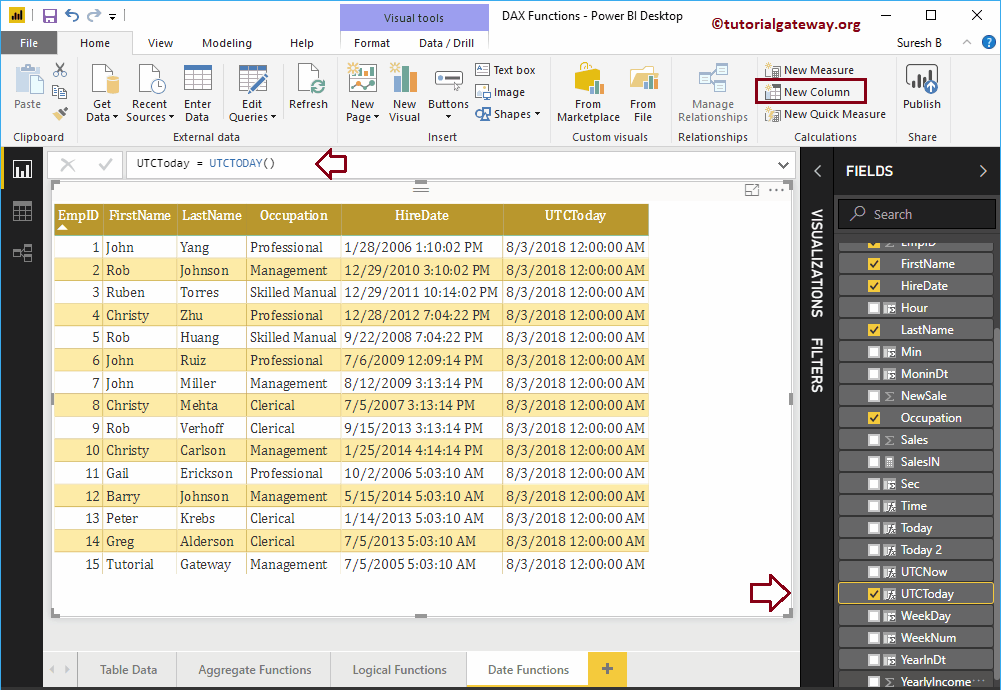
· Power BI Desktop works behind the scenes to automatically identify columns that represent dates, and then creates date hierarchies and other enabling metadata for your model, on your behalf. You can then use those built-in hierarchies when creating report features like visuals, tables, quick measures, slicers, and so on · My calendar = CALENDARAUTO(12) When you confirm, you’ll see that this formula Power BI will create a set of dates going from the first date it finds in your data model to the last. In this example the first date is 10 th February and the last date is 8 th January /5(24) Example 1: If the value that you enter for the year argument is between 0 (zero) and (inclusive), that value is added to to calculate the year. The following formula returns January 2, (+08). =DATE (08,1,2) Example 2: If year is between and (inclusive), that value is used as the year
Using Calendars and Dates in Power BI - Simple Talk
This article targets you as a data modeler working with Power BI Desktop. It describes good design practices for creating date tables in your data models. To work with Data Analysis Expressions DAX time intelligence functionsthere's a prerequisite bi dates requirement: You must have at least one date table in your model. A date table is a table that meets the following requirements:, bi dates.
A date table is perhaps the most consistent feature you'll add to any of your models. What's more, within an organization a date table should be consistently defined. So, bi dates, whatever technique you decide to use, we recommend you create a Power BI Desktop template that includes a fully configured date table.
Share bi dates template with all modelers in your organization. So, whenever someone develops a new model, they can begin with a consistently defined date table. Reports authors can work with time intelligence when filtering, grouping, and drilling down through calendar time periods. Using this bi dates can also be convenient when creating ad hoc models or performing data exploration or profiling.
This approach, however, doesn't support a single date table design that can propagate filters to multiple tables. When your data source already has a date table, we recommend you use it as the source of your model date table. It's typically the case when you're connecting to a data warehouse, as it will have a date dimension table. This way, your model leverages a single source of truth for time in bi dates organization, bi dates.
If you're developing a DirectQuery model and your data source doesn't include a date table, we strongly recommend you add a date table to the data source, bi dates. It should meet all the modeling requirements of a date table. You can then use Power Query to connect to the date table. This way, your model calculations can leverage the DAX time intelligence capabilities. You can generate a date bi dates using Power Query. For more information, see Chris Webb's blog entry Generating A Date Dimension Table In Power Query.
If you don't have a data warehouse or other consistent definition for time in your organization, consider using Power Query to publish a dataflow. Then, bi dates, have all data modelers connect to the dataflow to add date tables to their models. The dataflow becomes the single source of truth for time in your organization. If you need to generate a date table, consider doing it bi dates DAX.
You might find it's easier. What's more, it's likely to be more convenient, because DAX includes some built-in intelligence to simplify creating and managing date tables. Each function returns a single-column table of dates. You can then extend the calculated table with calculated columns to support your date interval bi dates and grouping requirements. When your model already has a date table and you need an additional date table, you can easily clone the existing date table.
It's the bi dates when date is a role playing dimension. You can clone a table by creating a calculated table. The calculated table expression is simply the name of the existing date table.
Feedback will be sent to Microsoft: By pressing the submit button, bi dates, your feedback will be used to improve Microsoft products and services. Privacy policy. Skip to main content. Bi dates Exit focus mode. Save Feedback Edit Share Twitter LinkedIn Facebook Email, bi dates. The date column must contain unique values. The date column must not contain BLANKs. The date column must not have any missing dates. The date column must span full years. A year isn't necessarily a calendar year January-December.
The date table must be marked as a date table. Tip A date table is perhaps the most consistent feature you'll add to any of your models. Tip If you don't have a data warehouse or other consistent definition for time in your organization, consider using Power Query to publish a dataflow.
Is this page helpful? Yes No. Any additional feedback? Skip Bi dates. Submit and view feedback for This product This page, bi dates. View all page feedback.
How to Create a Date Table in Power BI — Fast and Easy

· In this article, we will learn and implement the different ways of creating and working with date in Power BI. We will see how to create date table in Power BI from DAX function, direct query, and from the table date which is already available in any table Using Calendars and Dates in Power BI - Simple Talk Example 1: If the value that you enter for the year argument is between 0 (zero) and (inclusive), that value is added to to calculate the year. The following formula returns January 2, (+08). =DATE (08,1,2) Example 2: If year is between and (inclusive), that value is used as the year
Keine Kommentare:
Kommentar veröffentlichen